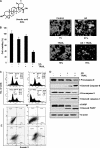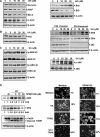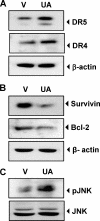Ursolic acid, a pentacyclin triterpene, potentiates TRAIL-induced apoptosis through p53-independent up-regulation of death receptors: evidence for the role of reactive oxygen species and JNK
- PMID: 21156789
- PMCID: PMC3037668
- DOI: 10.1074/jbc.M110.183699
Ursolic acid, a pentacyclin triterpene, potentiates TRAIL-induced apoptosis through p53-independent up-regulation of death receptors: evidence for the role of reactive oxygen species and JNK
Retraction in
-
Ursolic acid, a pentacyclin triterpene, potentiates TRAIL-induced apoptosis through p53-independent up-regulation of death receptors. EVIDENCE FOR THE ROLE OF REACTIVE OXYGEN SPECIES AND JNK.J Biol Chem. 2016 Aug 5;291(32):16924. doi: 10.1074/jbc.A110.183699. J Biol Chem. 2016. PMID: 27496965 Free PMC article. No abstract available.
Abstract
Discovery of the molecular targets of traditional medicine and its chemical footprints can validate the use of such medicine. In the present report, we investigated the effect of ursolic acid (UA), a pentacyclic triterpenoid found in rosemary and holy basil, on apoptosis induced by TRAIL. We found that UA potentiated TRAIL-induced apoptosis in cancer cells. In addition, UA also sensitized TRAIL-resistant cancer cells to the cytokine. When we investigated the mechanism, we found that UA down-regulated cell survival proteins and induced the cell surface expression of both TRAIL receptors, death receptors 4 and 5 (DR4 and -5). Induction of receptors by UA occurred independently of cell type. Gene silencing of either receptor by small interfering RNA reduced the apoptosis induced by UA and the effect of TRAIL. In addition, UA also decreased the expression of decoy receptor 2 (DcR2) but not DcR1. Induction of DRs was independent of p53 because UA induced DR4 and DR5 in HCT116 p53(-/-) cells. Induction of DRs, however, was dependent on JNK because UA induced JNK, and its pharmacologic inhibition abolished the induction of the receptors. The down-regulation of survival proteins and up-regulation of the DRs required reactive oxygen species (ROS) because UA induced ROS, and its quenching abolished the effect of the terpene. Also, potentiation of TRAIL-induced apoptosis by UA was significantly reduced by both ROS quenchers and JNK inhibitor. In addition, UA was also found to induce the expression of DRs, down-regulate cell survival proteins, and activate JNK in orthotopically implanted human colorectal cancer in a nude mouse model. Overall, our results showed that UA potentiates TRAIL-induced apoptosis through activation of ROS and JNK-mediated up-regulation of DRs and down-regulation of DcR2 and cell survival proteins.
Figures








Similar articles
-
Azadirone, a limonoid tetranortriterpene, induces death receptors and sensitizes human cancer cells to tumor necrosis factor-related apoptosis-inducing ligand (TRAIL) through a p53 protein-independent mechanism: evidence for the role of the ROS-ERK-CHOP-death receptor pathway.J Biol Chem. 2013 Nov 8;288(45):32343-32356. doi: 10.1074/jbc.M113.455188. Epub 2013 Sep 27. J Biol Chem. 2013. PMID: 24078627 Free PMC article.
-
Short-hairpin RNA-induced suppression of adenine nucleotide translocase-2 in breast cancer cells restores their susceptibility to TRAIL-induced apoptosis by activating JNK and modulating TRAIL receptor expression.Mol Cancer. 2010 Sep 28;9:262. doi: 10.1186/1476-4598-9-262. Mol Cancer. 2010. PMID: 20875141 Free PMC article.
-
ROS and CHOP are critical for dibenzylideneacetone to sensitize tumor cells to TRAIL through induction of death receptors and downregulation of cell survival proteins.Cancer Res. 2011 Jan 15;71(2):538-49. doi: 10.1158/0008-5472.CAN-10-3121. Epub 2010 Dec 2. Cancer Res. 2011. Retraction in: Cancer Res. 2018 Sep 1;78(17):5185. doi: 10.1158/0008-5472.CAN-18-2370. PMID: 21127198 Free PMC article. Retracted.
-
Molecular targets of TRAIL-sensitizing agents in colorectal cancer.Int J Mol Sci. 2012;13(7):7886-7901. doi: 10.3390/ijms13077886. Epub 2012 Jun 25. Int J Mol Sci. 2012. PMID: 22942679 Free PMC article. Review.
-
Research progress of ursolic acid's anti-tumor actions.Chin J Integr Med. 2014 Jan;20(1):72-9. doi: 10.1007/s11655-013-1541-4. Epub 2013 Dec 29. Chin J Integr Med. 2014. PMID: 24374755 Review.
Cited by
-
Ursolic acid induces neural regeneration after sciatic nerve injury.Neural Regen Res. 2013 Sep 25;8(27):2510-9. doi: 10.3969/j.issn.1673-5374.2013.27.002. Neural Regen Res. 2013. PMID: 25206561 Free PMC article.
-
Cancer prevention with promising natural products: mechanisms of action and molecular targets.Anticancer Agents Med Chem. 2012 Dec;12(10):1159-84. doi: 10.2174/187152012803833035. Anticancer Agents Med Chem. 2012. PMID: 22583402 Free PMC article. Review.
-
Sub-toxic dose of apigenin sensitizes HepG2 cells to TRAIL through ERK-dependent up-regulation of TRAIL receptor DR5.Mol Cells. 2013 Jan;35(1):32-40. doi: 10.1007/s10059-013-2175-2. Epub 2012 Dec 4. Mol Cells. 2013. PMID: 23224239 Free PMC article.
-
Ursolic Acid and Related Analogues: Triterpenoids with Broad Health Benefits.Antioxidants (Basel). 2021 Jul 21;10(8):1161. doi: 10.3390/antiox10081161. Antioxidants (Basel). 2021. PMID: 34439409 Free PMC article. Review.
-
Pomolic acid induces apoptosis in SK-OV-3 human ovarian adenocarcinoma cells through the mitochondrial-mediated intrinsic and death receptor-induced extrinsic pathways.Oncol Lett. 2013 Jan;5(1):386-390. doi: 10.3892/ol.2012.985. Epub 2012 Oct 22. Oncol Lett. 2013. PMID: 23255955 Free PMC article.
References
-
- Butler M. S., Newman D. J. (2008) Prog. Drug Res. 65, 3–44 - PubMed
-
- Liu J. (1995) J. Ethnopharmacol. 49, 57–68 - PubMed
-
- Aggarwal B. B. (2003) Nat. Rev. Immunol. 3, 745–756 - PubMed
-
- Es-saady D., Simon A., Ollier M., Maurizis J. C., Chulia A. J., Delage C. (1996) Cancer Lett. 106, 193–197 - PubMed
-
- Hsu Y. L., Kuo P. L., Lin C. C. (2004) Life Sci. 75, 2303–2316 - PubMed
Publication types
MeSH terms
Substances
Grants and funding
LinkOut - more resources
Full Text Sources
Medical
Research Materials
Miscellaneous

